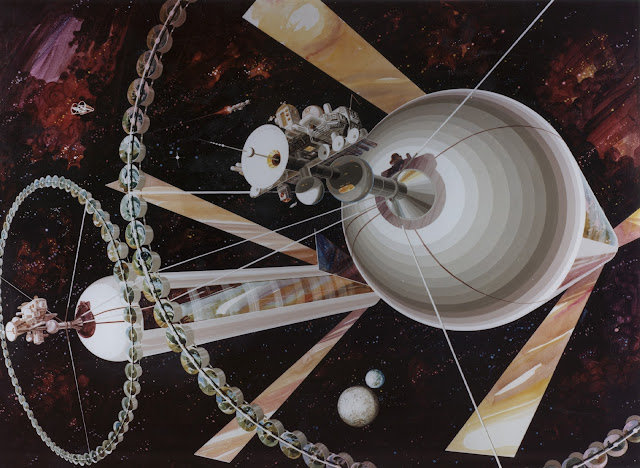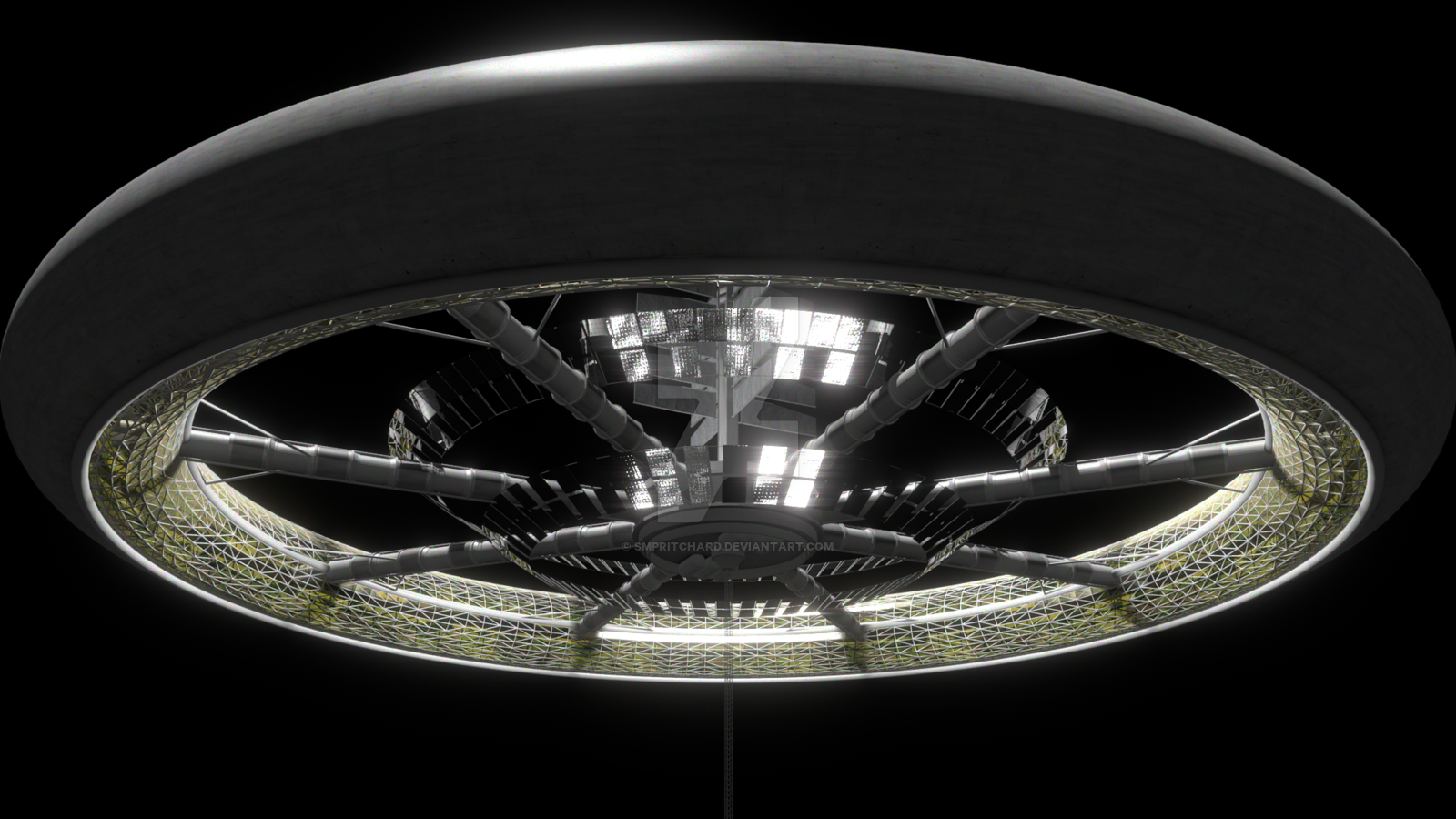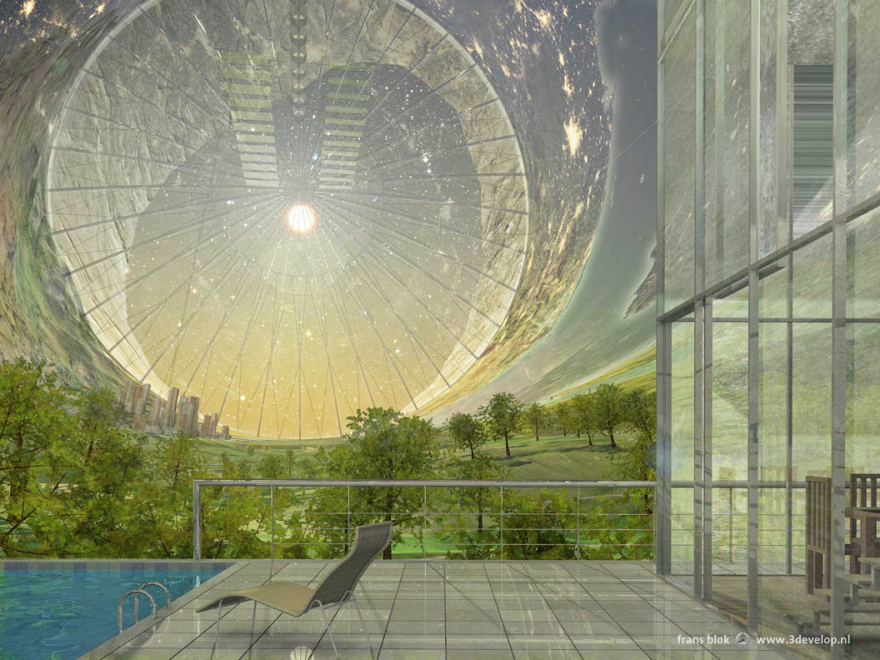Gerard O’Neill’s Big Idea
In the mid 70s academic physicist Gerard O’Neill asked the question: how big could you build free standing structures in space, which you could rotate to provide artifical gravity (through centrifugal force)? The answer, it seems, is surprisingly large; using steel, up to 6kms radius. Hence came the idea of O’Neill style habitats. These can be of several shapes:
- Spherical maximises the internal volume for a given weight, but artificial gravity tapers off from the “equator”. A better shape is a cylinder, all the internal surface area can be maintained at constant gravity. This shape is the basis of the O’Neill cylinder shown below.
 Source: https://commons.wikimedia.org/wiki/File:Spacecolony1.jpg
Source: https://commons.wikimedia.org/wiki/File:Spacecolony1.jpg
- A possible alternative is a torus. This may actually be more sensible as it has lower internal volume and thus air requirements. One surface could be flattened to provide better living area.

Source:https://smpritchard.deviantart.com/art/Stanford-Torus-579632518
The maximum rate of rotation which is comfortable is around 2 per minute, which gives a centrifugal force of 1g at a radius of 225 metres.
O’Neill’s idea was to fill the interior with lunar regolith (the powdery surface covering on the moon) , acting as soil, some 2 metres depth would allow agriculture and even trees. As discussed in subsequent posts, this is probitively expensive and in any case unnecessary.
On Earth good agricultural areas have natural soil with nutrients, and unless irrigated, natural rainfall. None of these would be the case with an artificial habitats. The most productive way to grow most crops would be hydroponics, with no soil, or a limited depth of inert medium (crushed rock from asteroid mining would do)and nutrients supplied in the irrigating water.
 Source: Frans Blok http://www.3develop.nl/
Source: Frans Blok http://www.3develop.nl/
Power would be from solar panels, and with the sun shining 24/7, it should be cheap. Experience with satellites shows that abrasion from micrometeorites is containable, with a panel life of around 20 years. Early designs for habitats suggested transparent glass strips to let in sunlight, or by mirrors though end caps, but these would soon be made opaque through micrometeorite abrasion and weaken radiation protection. A simpler and better way is to pipe in sunlight through optic fibres, also makes it easy to set up an Earth type day with alternating light and dark periods.
Such habitats could orbit anywhere, for convenience near the earth or moon. O’Neill suggested near Lagrange points, which orbit the sun keeping a fixed distance from Earth and Moon. There are five of these, but three are in unstable equilibrium, so around points L4 and L5 are potential sites. However, because of that stability, cosmic dust accumulates there. In practice, somewhere between Earth and Moon would suffice.
Potentially, these would be by far the largest structures built by man, and could accommodate some sizeable populations. For example, a pair of cylinders each 10kms long and with 3km radius would have an internal surface area of 376 sq.km.
Populated at 500 people/sq.km (comparable to some parts of Europe, and south and east Asia) that is 188,000 people, equivalent to a fair size city, but leaving room for farms and wild nature as well as housing. Indeed one could double the density to 1000/sq.km and reach a population of close to 400,000 people and yet leave plenty of room for parks, forests and lakes. How is that possible? It is because a controlled environment would allow intensive agriculture and multiple crops a year, limiting the area needed for farms. An example on Earth is the island of Java, where a dense self sufficient population arose because the combination of rich volcanic soil and equatorial climate. Java has 150 million people at a density of 1100/sq.km yet large parts of the island are covered with those self same volcanoes and are uninhabited. Bangladesh, the flat parts of Japan, and parts of India and China have comparable densities.
Would people want to live in a rotating can with no outside view? Some densely populated parts of the world such as N.W.Europe, Japan, N.E USA and southern California, are among the wealthiest and most desirable places in the world. – and most people there live in cities. You could choose whatever climate one wanted (it could differ between cylinders), and agricultural self sufficiency should not be difficult, with multiple crops a year.
Thus O’ Neill type colonies provide a virtually unlimited potential for human settlement in space, subject to some very big ifs:
-
If they can be made a safe, from cosmic radiation and meteorites
-
If the resources to construct them and make them habitable are available
-
If the potential cost is not too astronomical (forgive the pun)
These issues will be addressed in subsequent posts.
Previous chapter:
Moon and Planets: Not Suitable for Settlement?
Next chapter:
Protecting Habitats from Cosmic Radiation